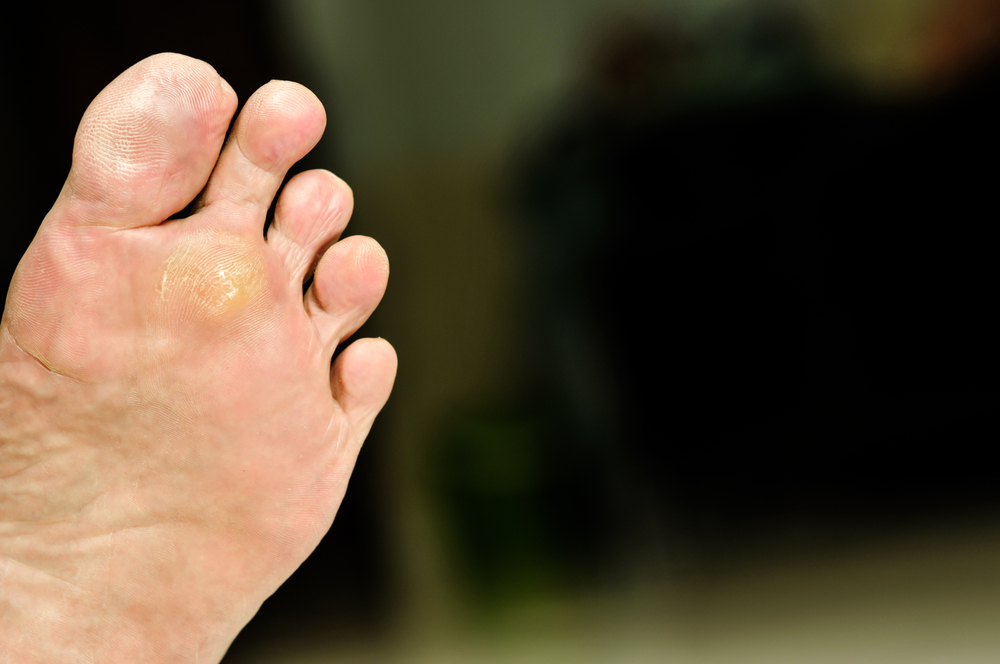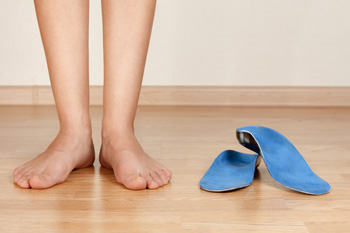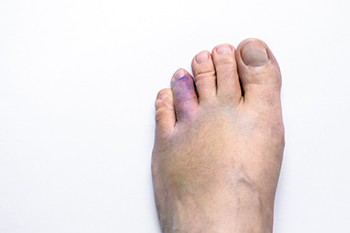
Plantar warts are a type of skin growth on the bottom of the foot caused by human papillomavirus, or HPV, infection. There are many types of HPV, and some of them are linked to skin warts. Plantar warts are a frequent type of skin wart. Because plantar warts can be uncomfortable, many people seek treatment from podiatrists. Plantar warts can be difficult to treat, and many treatments do not work. Different types of HPV are linked to different warts, and understanding which type causes the wart can help improve treatment and reduce side effects. If you or your child has developed a plantar wart, it is suggested that you schedule an appointment with a podiatrist who can guide you toward the treatment option that is right for you.
Plantar warts can be very uncomfortable. If you need your feet checked, contact one of our podiatrists from Farah Podiatry Associates. Our doctors will assist you with all of your foot and ankle needs.
About Plantar Warts
Plantar warts are the result of HPV, or human papillomavirus, getting into open wounds on the feet. They are mostly found on the heels or balls of the feet.
While plantar warts are generally harmless, those experiencing excessive pain or those suffering from diabetes or a compromised immune system require immediate medical care. Plantar warts are easily diagnosed, usually through scraping off a bit of rough skin or by getting a biopsy.
Symptoms
Treatment
To help prevent developing plantar warts, avoid walking barefoot over abrasive surfaces that can cause cuts or wounds for HPV to get into. Avoiding direct contact with other warts, as well as not picking or rubbing existing warts, can help prevent the further spread of plantar warts. However, if you think you have developed plantar warts, speak to your podiatrist. He or she can diagnose the warts on your feet and recommend the appropriate treatment options.
If you have any questions please feel free to contact our office located in Trenton, MI . We offer the newest diagnostic and treatment technologies for all your foot and ankle needs.

Custom-made orthotics are a valuable solution for alleviating foot pain and addressing various foot conditions. These personalized shoe inserts are designed to provide optimal support and alignment for an individual's unique foot structure and gait patterns. Custom orthotics offer precise support tailored to your specific needs. They are crafted based on a detailed assessment of your foot anatomy, including arch height, pronation, and other biomechanical factors. This ensures they provide the right level of support where needed, redistributing pressure evenly, and reducing strain on problematic areas. Custom orthotics can also improve alignment and stability. Correcting imbalances in your feet, ankles, or legs can reduce the stress on joints and muscles, promoting a more natural and efficient walking or running pattern. Furthermore, orthotics can alleviate pain caused by plantar fasciitis, bunions, or flat feet. They can provide cushioning and shock absorption, reducing discomfort during daily activities or sports. If you have persistent foot pain, it is suggested that you schedule an appointment with a podiatrist to discuss whether custom-made orthotics are a viable option for you.
If you are having discomfort in your feet and would like to try orthotics, contact one of our podiatrists from Farah Podiatry Associates. Our doctors can provide the care you need to keep you pain-free and on your feet.
What Are Orthotics?
Orthotics are inserts you can place into your shoes to help with a variety of foot problems such as flat feet or foot pain. Orthotics provide relief and comfort for minor foot and heel pain but can’t correct serious biomechanical problems in your feet.
Over-the-Counter Inserts
Orthotics come in a wide variety of over-the-counter inserts that are used to treat foot pain, heel pain, and minor problems. For example, arch supports can be inserted into your shoes to help correct overarched or flat feet, while gel insoles are often used because they provide comfort and relief from foot and heel pain by alleviating pressure.
Prescription Orthotics
If over-the-counter inserts don’t work for you or if you have a more severe foot concern, it is possible to have your podiatrist prescribe custom orthotics. These high-quality inserts are designed to treat problems such as abnormal motion, plantar fasciitis, and severe forms of heel pain. They can even be used to help patients suffering from diabetes by treating foot ulcers and painful calluses and are usually molded to your feet individually, which allows them to provide full support and comfort.
If you are experiencing minor to severe foot or heel pain, it’s recommended to speak with your podiatrist about the possibilities of using orthotics. A podiatrist can determine which type of orthotic is right for you and allow you to take the first steps towards being pain-free.
If you have any questions please contact our office located in Trenton, MI . We offer the newest diagnostic and treatment technologies for all your foot and ankle needs.

Numerous studies now highlight the connection between body weight and foot health. They suggest that a high body mass index, or BMI, can profoundly influence foot structure and function, thereby increasing the risk of painful conditions. The correlation between BMI and foot pain is well-documented. Research underscores the increased likelihood of abnormal plantar pressures, altered foot function, and changes in foot structure among individuals classified as obese, with a BMI of 30 or higher, or overweight, with a BMI between 25 and 29. These findings also reveal a heightened susceptibility among heavier individuals to foot complications, such as osteoarthritis, tendinitis, and plantar fasciitis, which can significantly affect their quality of life. Podiatrists now face the challenge of tailoring their approaches to foot care for patients with higher BMIs, considering factors like decreased tolerance for high-impact exercise and altered plantar pressures. This shift may influence the prescription of non-aerobic exercise and the recommendation of stiffer, thicker orthotic devices. If you have concerns about foot or ankle pain that may be related to weight, it is suggested that you schedule an appointment with a podiatrist.
The more you weigh, the harder your feet must work to support your body. If you’re an obese individual and are concerned about your feet, contact one of our podiatrists from Farah Podiatry Associates. Our doctors can provide the care you need to keep you pain-free and on your feet.
Obesity and Your Feet
People who are overweight are putting more pressure on their ankles, knees, and hips as well as their feet. This unfortunately can lead to variety of different issues.
Problems & Complications Stemming from Obesity
If you have any questions, please feel free to contact our office located in Trenton, MI . We offer the newest diagnostic and treatment technologies for all your foot care needs.

Bunion removal surgery, a definitive step toward alleviating the discomfort and deformity caused by bunions, marks a transformative journey for many individuals. The surgical procedure involves the correction of the misalignment of the metatarsophalangeal, or MTP, joint at the base of the big toe. This joint deviation, commonly associated with the development of bunions, can lead to pain, swelling, and difficulty in finding suitable footwear. The surgical process typically includes realigning the affected joint, removing excess bone, and addressing any soft tissue abnormalities. Following the surgery, a period of rest and rehabilitation is vital to ensure optimal recovery. While bunion removal surgery is a significant decision, it can offer a renewed sense of comfort and mobility for those who have struggled with the limitations imposed by this common foot condition. If you have a bunion, and are considering surgery for removal, it is strongly suggested that you consult a podiatrist who determine if this a correct treatment choice for you.
Foot surgery is sometimes necessary to treat a foot ailment. To learn more, contact one of our podiatrists of Farah Podiatry Associates. Our doctors will assist you with all of your foot and ankle needs.
When Is Surgery Necessary?
Foot and ankle surgery is generally reserved for cases in which less invasive, conservative procedures have failed to alleviate the problem. Some of the cases in which surgery may be necessary include:
What Types of Surgery Are There?
The type of surgery you receive will depend on the nature of the problem you have. Some of the possible surgeries include:
Benefits of Surgery
Although surgery is usually a last resort, it can provide more complete pain relief compared to non-surgical methods and may allow you to finally resume full activity.
Surgical techniques have also become increasingly sophisticated. Techniques like endoscopic surgery allow for smaller incisions and faster recovery times.
If you have any questions please feel free to contact our office located in Trenton, MI . We offer the newest diagnostic and treatment technologies for all your foot and ankle needs.

A broken toe, though seemingly minor, unfolds as a painful reality, demanding attention to its distinctive features. The anatomy of toes, comprising small bones known as phalanges, renders them susceptible to fractures. A break in the toe may occur from trauma, such as dropping a heavy object on it or stubbing it against a hard surface. The symptoms of a broken toe are noticeable through localized pain, swelling, and bruising, often accompanied by difficulty in bearing weight on the affected toe. A limited range of motion and deformity, where the toe appears crooked or misaligned, are indicative signs. The pain intensifies with movement or pressure, and in some cases, there may be a noticeable cracking sound at the time of injury. If you have broken your toe, it is suggested that you visit a podiatrist as quickly as possible who can perform a correct diagnosis and treat it accordingly.
A broken toe can be very painful and lead to complications if not properly fixed. If you have any concerns about your feet, contact one of our podiatrists from Farah Podiatry Associates. Our doctors will treat your foot and ankle needs.
What to Know About a Broken Toe
Although most people try to avoid foot trauma such as banging, stubbing, or dropping heavy objects on their feet, the unfortunate fact is that it is a common occurrence. Given the fact that toes are positioned in front of the feet, they typically sustain the brunt of such trauma. When trauma occurs to a toe, the result can be a painful break (fracture).
Symptoms of a Broken Toe
Generally, it is best to stay off of the injured toe with the affected foot elevated.
Severe toe fractures may be treated with a splint, cast, and in some cases, minor surgery. Due to its position and the pressure it endures with daily activity, future complications can occur if the big toe is not properly treated.
If you have any questions please feel free to contact our office located in Trenton, MI . We offer the newest diagnostic and treatment technologies for all your foot and ankle needs.